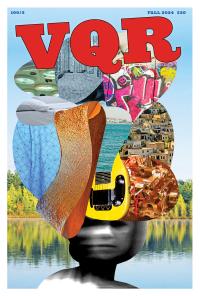
VQR Takes to Styling
By JEROME WEEKS / The Dallas Morning News
They used to look as alike as close family members, and some still do, those literary quarterlies and high-brow journals: The Paris Review, The Yale Review, The New Criterion, Partisan Review and Southwest Review at Southern Methodist University.
They were the size of a trade paperback book but without the glossy paper or color photos – other than the splash of abstract art traditionally on the cover. Those covers often had Play-Doh-colored stock, yet it was a mark of the journals’ seriousness, the fineness of their thinking, that they still looked somber, almost pristine in their typefaces. They dispensed high-critical sagacity, even their fiction and donnish humor.
Then in the ’80s and ’90s came Granta, Dave Eggers’ McSweeney’s , DoubleTake, Oxford American, Tom Frank’s The Baffler and, in 2003, The Believer. Life got very lively in the world of influential literary periodicals. What signifies sophistication today – beyond the quality writing – is the smart use of photographic illustrations with political journalism, plus slick graphic styles, deadpan humor and a jazzier range of interests, particularly an engagement with popular culture – from McSweeney’s coy ironies to The Baffler’s head-on political-economic analysis. If you want to see how zippy these journals have gotten, check out www.grandstreet.com.
Old Virginny won’t cut it
Now comes a revamped Virginia Quarterly Review with sizable new ambitions. The current issue (spring 2004) boasts contributions from E.L. Doctorow and Nick Bantock (of Griffin & Sabine collage-art fame), but most eye-catching, on the full-color cover is novelist Michael Chabon’s comic-book hero, the Escapist – from his novel The Amazing Adventures of Kavalier and Klay. The previous issue – addressing the 50th anniversary of the Brown vs. Board of Education desegregation decision – featured work by Toni Morrison and Romare Bearden. The entire package is a striking upgrade in crisp design and name-brand authors. “I was given a mandate from the board to shake things up,” says Ted Genoways, 32, a Texas Tech University graduate who became the new editor of the VQR last year. “A brand-new look, an expanded Web site, a new identity.”
Money does help
Fortunately for Mr. Genoways, although the University of Virginia pays the salaries and operating costs (“they keep the lights and heat on”), the VQR is mostly funded from longstanding endowments. Still, “we had to figure out new ways to publish it, more cost-effective ways,” he says. As it is, having dropped the old linotype press and updated the 1990-vintage computers that the journal used, a new VQR costs only $20,000 to print and mail; an old one cost $16,000.
Mr. Genoways likes the comparisons to Granta because the British-American journal is the role model for reviving an aged periodical (it was nearly dead in the late ’70s) and for gaining a wider readership (now 30,000 in America, 75,000 worldwide).
“They do a great job of bringing together top-shelf fiction, travel writing and political reporting,” he says. “And that’s very much what we’re trying to do – plus poetry and book reviews. I like to think of us as four magazines in one.”
Getting the word out
As quarterlies, Granta and McSweeney’s have also pioneered a new distribution model. Newsstands run on weekly-monthly schedules. A quarterly can sell out and never be asked for more copies. So McSweeney’s and Granta sell their magazines like books.
Such quarterlies have always offset their tiny readerships with prestige and influence. The new journals are changing that equation a bit: more visual snap, a less churchy tone, hipper topics – and, possibly, bigger audiences.
